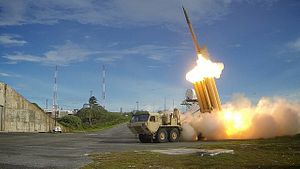The development of the North Korean ballistic missile program seems inexorable. If recent history is any guide, it suggests that Pyongyang will order its rocket scientists and technicians to doggedly pursue their life’s work until success is achieved and can be trumpeted to the international community.
Looking at the DPRK’s long-range missile program, the Kim dynasty’s determination to exhibit rocketry prowess is evident in the failed Paektusan and Taepodong model tests on August 31, 1998 and July 5, 2006 respectively, followed by the failed Unha model rocket launches in 2009 and 2012. Eventually, North Korea’s determination was rewarded with a successful Unha launch in December 2012.
This tenacity was also on display in the intermediate-range ballistic missile (IRBM) category. In his quest to build a credible ability to threaten U.S. Pacific territories like Guam with a nuclear strike, current DPRK leader Kim Jong-un has pushed his missile program through five unsuccessful tests of the Hwasong-10 IRBM this year, on April 15, April 28 (two on the same day), May 31 and June 22, before a successful sixth test on the same day as the fifth failure.
Stubborn Resolve
Then, on July 9, Kim’s missile program attempted to test a submarine-launched ballistic missile (SLBM), a KN-11 or Bukguekseong-1 SLBM. This missile exploded after reaching an altitude of about 10 km and a lateral range of only a few kilometers. Still, if history is any guide, this failure should not be contemptuously dismissed. Pyongyang is nothing if not persistent. Excluding the most recent launch, the KN-11 has already been tested nine times since October 2014 from both land and marine platforms and from submarines, with varying levels of success.
While South Korea’s national intelligence agency has predicted that Pyongyang could deploy an operational SLBM by 2019, it would not be surprising if the goal is reached much earlier than this, if the rushed and eventual successful testing of the Hwasong-10 in the period from April to June this year is anything to go by.
China’s Concerns
If the deployment of effective North Korean IRBMs and SLBMs is seen as inevitable, it would only make sense for the U.S.-ROK alliance to deploy the U.S.-made Terminal High Altitude Area Defense (THAAD) missile system on South Korean soil in order to intercept any missiles that the DPRK might launch in any future crisis. However, the range of the THAAD radars and interceptor missiles also mean this system can intercept missiles fired from China, thereby eroding the efficacy of the PRC’s strategic nuclear deterrence vis-à-vis the U.S. Hence, Beijing bitterly opposes Washington’s and Seoul’s joint decision, taken on July 8 2016, to deploy THAAD in the ROK.
But Beijing cannot have its cake and eat it too. In all previous nuclear or missile crises instigated by Pyongyang, China has always insisted that North Korea be reasoned and negotiated with, while concurrently dissuading the U.S. and ROK from implementing militarily punitive measures, and refusing to apply any economic sanctions that would seriously pressure the DPRK. From a cynical perspective, it can be argued that the PRC’s leadership wants both Washington and Seoul to maintain a policy of perpetual strategic patience, and treat North Korea with “kid gloves” while respecting Chinese deterrence sensitivities.
Reality Check
From past experience, it can be seen that the Kim regime is all too willing to use nuclear and missile aggrandizement as part of a coercive negotiating strategy to obtain aid from the U.S. and/or South Korea. Since carrots have not been effective in bringing any lasting positive change in North Korea behavior, it is reasonable to resort to the stick.
Additionally, acknowledging that the DPRK can, given sufficient time, develop successful IRBM, SLBM and possibly intercontinental ballistic missile technology demonstrators that perform well in tests, action can be taken to limit Pyongyang’s strategic missile arsenal that can threaten targets beyond Japan to the low dozens or even less. Given that previous United Nations Security Council Resolutions have already prohibited all North Korean ballistic missile tests, China as the DPRK’s only significant conduit to the world must strictly prohibit all rocket fuel or fuel production chemicals exports, along with any materials components shipments that might be useful for missile production.
Finally, it would be hypocritical of Beijing to object to THAAD deployment while refusing to apply coercive economic leverage against Pyongyang in order to influence the Kim regime’s choices. If Kim Jong-un chooses to consistently thumb his nose at Beijing using nuclear and missile shenanigans, perhaps a two-week closure of all land crossings and sea ports to North Korean commercial traffic would remind the North Korean leader that just as his grandfather and father could not ignore the strategic interests and dictates of the PRC, neither can he.
Liang Tuang Nah, PhD is a Fellow at the Institute of Defense and Strategic Studies, a constituent unit of the S. Rajaratnam School of International Studies (RSIS), Nanyang Technological University.

































